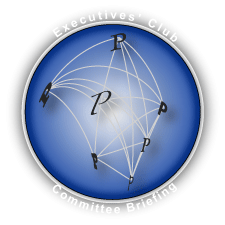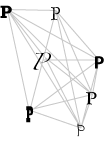Media Reflects Power Shift away from Producers to Consumers—Glimpses of Consumer Empowerment
 The Executives’ Club of Chicago assembled a visionary panel to give Midwest business leaders their advice for media communications in the (“new” ,^) digital age. Rishad Tobaccowala, CEO, Denuo Group and Chief Innovation Officer, Publicis; Dr. Jim Taylor, Vice Chairman, The Harrison Group and Emily L. Barr, President & General Manager, ABC 7 Chicago were panelists, and Susan D. Whiting, Chairman, Nielsen Media Research moderated the breakfast, which took place 30 January 2007 at Chicago’s Mid-America Club.
The Executives’ Club of Chicago assembled a visionary panel to give Midwest business leaders their advice for media communications in the (“new” ,^) digital age. Rishad Tobaccowala, CEO, Denuo Group and Chief Innovation Officer, Publicis; Dr. Jim Taylor, Vice Chairman, The Harrison Group and Emily L. Barr, President & General Manager, ABC 7 Chicago were panelists, and Susan D. Whiting, Chairman, Nielsen Media Research moderated the breakfast, which took place 30 January 2007 at Chicago’s Mid-America Club.
Ours is rapidly becoming a P2P world in which individuals communicate with individuals digitally, and this represents a profound shift for media companies, their clients and everyone’s customers. The focus of the morning discussion was “media”—television, print, radio—which are still largely organized to deliver one message to an audience of many. Of course, the “mass” has always been comprised of individuals, but their alternatives to mass media have been few until fairly recently. Now they are tuning out mass messaging in favor of more relevant communications, which increasingly come from—other individuals. Meantime, people are increasingly connected via the Internet (whether through mobile phones, computers, cable, VoIP), and the scale of consumer communications is beginning to approach that of the mass media.
What global enterprises and their media advisors want to know is, “How do we evolve and ensure that we remain relevant in light of this emerging consumer empowerment?”
The Panel
The speakers are all media experts, and Rishad and Jim are recognized futurists:
- Rishad Tobaccowala simultaneously serves as CEO of Denuo and Chief Innovation Officer of Publicis Groupe Media, which oversees two major media networks, Starcom Mediavest Group (SMG) and Zenith Optimedia, which allocate over $40 billion in global media spending. He has over 25 years of marketing and strategy experience across a wide spectrum of clients and companies, and he has gained wide recognition as a futurist and visionary. Select citations are: “One of 2005’s Best Leaders” (Business Week), one of five “Marketing Innovators” (Time Magazine), the Interactive Hall of Fame (Advertising Age) and Media Strategist All-star for 2005 (OMMA magazine).
- Dr. Jim Taylor is an acknowledged expert in the use of interactive media for the community format, future forecasting and customer acquisition and retention. He advises many of the world’s leading packaged goods, software, media, banking, customer service, business and financial services corporations. He has served in senior executive roles at Yankelovich, Skelly & White, Hill and Knowlton, Ernst & Young, Gateway Computers and Iomega Corporation. He has been named “Marketer of the Year” by Brandweek as well as one of America’s five leading business futurists by The Wall Street Journal.
- Emily L. Barr has been President and General Manager of ABC 7 Chicago (WLS-TV) since April 1997. During her tenure, ABC 7 has strengthened its dominance in the market, and its entire news lineup is currently rated #1 in Chicago. Barr’s vision to create a street-level studio to give viewers a window into the world of television was realized in April 2006, when the state-of-the-art State Street Studio debuted. Barr has positioned ABC 7 as the most technologically advanced television station in Chicago. She is actively involved in the Chicago community and has been honored with many awards for her community service including a Chicago Urban League Award and a 2006 Spirit Award, which is given by the Niagra Foundation for promoting diversity, tolerance and global fellowship.
- Susan D. Whiting is Chairman of Nielsen Media Research, the nation’s television ratings company. She also serves as Executive Vice President of The Nielsen Company, a global information and media company with leading market positions and recognized brands in marketing information, media information, and trade shows. Susan was named one of The Wall Street Journal’s “50 Women to Watch” for 2006. She also has been a recipient of the Humanitarian Award from the Leukemia and Lymphoma Society and the Outstanding Female Role Model award from the NBA Wives Association. In 2003, she was named one of Multichannel News’ Wonder Women.
Susan Whiting moderated with aplomb, and I’ll be true to her organization of the points made and add my Analysis and Conclusions at the end. The morning began with the panelists’ reflections of the most important media events of 2006 and end with their predictions for the most important trends for 2007.
The most important media events of 2006 were “newest” media
- Emily: the YouTube phenomenon and Apple’s iPhone announcement
- Rishad: people-generated media came of age in 2006
- Jim: YouTube is BIG. Many videos get six-figure audiences very quickly
 Consumer media are not a flash in the pan
Consumer media are not a flash in the pan
- Rishad: consumer media are definitely here to stay, especially when you take into account the various roles consumers play (producing or re-transmitting content). Also, it’s important to realize that consumer media mimic traditional media ideas.
- Emily: there’s no practical use for it yet. People still want shared (mass) experience.
- Jim: media are only part of the trend. Kids are growing up producing content, and they think nothing of it. They typically use cell phones (camera, video), laptops, cameras, blogs and social networking sites as a matter of habit. The nature of being a person is defined by the desire to reach out, to form tribes, and the adult world is not controlling it. This forces us to reevaluate our assumptions by asking, “What does it mean to have consumer relationships?”
Consumer media do not herald the demise of “traditional media”
- Emily: during the last 27 years, countless people have predicted the end of mass media, and it hasn’t happened. Today, television has unprecedented revenues, and growth, although not what it once was, is solid. New media have an additive effect. Kids especially experience three or four media simultaneously, on demand. Local broadcast is investing in new media, but the ROI isn’t there yet. It’s approached as an R&D initiative. It will produce more value in time.
- Susan: Nielsen sees the highest ratings ever as well as an unprecedented number of TV sets—per home and per person. The average home has more than one TV per person.
- Rishad: three key trends are:
- There is more TV than before
- Electronic media trump print. In the U.S., print is losing audience quickly. Kids today hate newspapers, and the value of audiences is changing from mass to one to one: for example (figures show order of magnitude, may not be exact), the New York Times print readers are worth $850 while online readers are worth $35. However, in India, print is huge and growing quickly. Magazines are chic.
- B2B brands are fading quickly. It will be half the size within three years, like the yellow pages. The need for vertically-focused intermediaries is dropping.
- Jim: there are many innovation opportunities. For example, a Nantucket real estate developer provides local television (private) that has intense local content and delivers very high attention rates among residents.
The conflict between targeting and privacy
- Jim: assemble “alpha” communities (whose members are willing to collaborate), and pay them with incentives. They become advocates of your products and enable “network radiation.” Viral marketing leads TV now.
- Rishad: three issues are especially relevant here: privacy, security and ignorance. In the U.S., people compulsively share many things you’d never anticipate (and give up privacy). However, security is a much different issue because someone else steals private information (and prerogative), and analog and digital theft are big problems. Ignorance is widespread: people at all levels don’t realize that, once something is out there (on the Internet), it lives forever; there’s no putting it back into the bottle. What kids post on their MySpace now will haunt them later when they are running for political office.
- Emily: young children inherently recognize that they don’t use their real names when they’re online. TV is trying to figure out how to support the “individual broadcast” concept with advertising.
Advice for risk-adverse companies thinking about using “new media”
- Emily: mass media will continue to have a role. There is opportunity for creating synergy between commercials and websites. Think about how people find information about your products or services. Make sure to have a vibrant website.
- Rishad: listen to what people are saying about your company and products. Check blogs, YouTube, Flickr, etc. People are marketing to themselves. Observe how they do it. Your company doesn’t matter (it’s customers that matter). Many companies are still organized for the old world (around products). Recognize that the battle for talent is key to competitiveness. Talented people don’t want to work to companies that don’t get it.
- Jim: recognize that (an average person) has access to 1,000 TV channels, 1,000 magazines and 1,000 websites, and s/he will spend 60 hours each week with them. Their selection is based on their interests; they care less about the medium. They create their own lives by choosing what to experience. Your company must be accessible; you must be able to deliver content across whatever distribution channel the customer chooses (will probably be multiple). Profit margins are directly proportional to level of awareness.
How to get your message noticed
- Rishad: pool (media) budgets; jettison media-specific budgets. Instead, adopt a product-focused approach that’s focused on a customer. Your best customers become brand advocates; cover them and cater to them. Spend money listening to customers. Search should be used by everybody because it’s how customers find you (especially when they’re in buying mode).
- Rishad: a big trend in media is that you will have to spend far more to reach fewer customers, but those customers will be far more valuable. The economics of mass are over.
Advice for getting colleagues/clients to change their thinking
- Jim: create an alpha customer community, and go to them with test concepts. Let them become your advocates. Broadcast media are adopting pay models, like radio (Sirius, XM) and TV (cable). The shift is to consumers, away from producers.
- Rishad: spend $1,000 and get an iPod and a slingbox. You need to realize how customers are in control of content now. Take some time and research (the person whose behavior you’re trying to influence), focusing on his/her passions, especially personal. The relationship is personal now (not product-based). Numbers and accountability are a part of all media now—and only becoming more so.
- Emily: content is key. It’s easier than ever to get the word out, but you have to believe in the product and have a great story.
Adopt a global view of communications
 Jim: you must have a global strategy and brand promise. This must include a great story that resonates with morality, so it animates the human spirit. (Sales) volume is proportional to the number of people (that connect with your message) worldwide. Thinking on a by-country basis doesn’t make sense anymore. Manage your reach, and pay attention to emerging countries like China, Brasil and Indonesia. Have a single point of view.
Jim: you must have a global strategy and brand promise. This must include a great story that resonates with morality, so it animates the human spirit. (Sales) volume is proportional to the number of people (that connect with your message) worldwide. Thinking on a by-country basis doesn’t make sense anymore. Manage your reach, and pay attention to emerging countries like China, Brasil and Indonesia. Have a single point of view.- Rishad: all digital media are global and, now with Slingbox, broadcast media are global, too. There is no more “product arbitrage” in which companies dump (First World) has-been products on emerging (Third World) countries. Smart companies are paying attention to global trends in website traffic—and deciding where to launch products based on traffic.
- Emily: Slingbox means that local content is available everywhere.
Mobile marketing trends
- Jim: SMS is huge. The average kid has 14 buddies, and interactive, participatory TV is growing. In Europe, entire TV programs are paid for by SMS messages. It’s “pay to play” TV. Companies can get real-time feedback on everything, too.
- Rishad: mobile won’t amount to much for advertising; its strength is marketing. It offers immediacy. For example, H-P is working on a project to SMS printer models on demand to registered customers, which will be useful when they are trying to buy a new (printer) cartridge. Mobile will evolve with e-wallet capability.
- Emily: it extends your brand.
The most important media trends for 2007
- Jim: shopping will continue to bifurcate:
- 20% “impulse” shopping (the “normal” shopper)
- 80% “rules-governed” shopping (research via web)
- By using the Internet, the average household increases its purchasing power by 50%. Margins based on ignorance are going.. going.. ….
- Rishad: the recognition of this reality:
- There are 3 relevant networks: IP (Internet Protocol), P2P (peer to peer) and Home networks.
- There are three identities that people have (I believe he meant “work,” “home” and “digital” ones like Second Life; the latter splinter into multiples).
- Ellen: don’t want to predict, except that there will be even more TVs.
Analysis and Conclusions
Consumer and Legacy Media
 The economics and structure of the media “industry” reflect the Industrial Economy in which they were designed (for more, see How the Knowledge Economy Will Transform Markets and the Producer/Consumer Relationship). The simplicity (relative to today) of one-to-many communication will be hard for stakeholders to give up. Those that do not force themselves to get out of their comfort zones will hit the relevance point of no return within the next five years.
The economics and structure of the media “industry” reflect the Industrial Economy in which they were designed (for more, see How the Knowledge Economy Will Transform Markets and the Producer/Consumer Relationship). The simplicity (relative to today) of one-to-many communication will be hard for stakeholders to give up. Those that do not force themselves to get out of their comfort zones will hit the relevance point of no return within the next five years.- The media that are driving consumer empowerment will follow a classic adoption pattern in which visionaries and early adopters initially prove out concepts (we are in this stage now). They will have to survive a period of establishment skepticism (Geoff Moore’s “chasm”) before their pick-up and ramp-up to dominance.
- I agree with the speakers that the rise of consumer media doesn’t mean that the need for mass media will disappear. Chris Anderson got this right in his new book, The Long Tail: consumer media will have an important and probably dominant place, but we will still want to have pervasive group experience as well. I like the way he puts it, “Think ‘and,’ not ‘or.'” That said, consumer media will continue to subtract attention from traditional media.
- Many conservative business executives will mistake the visionaries and early adopters as “slightly relevant” and not much to worry about. Don’t entertain false complacency. Remember how your bosses were thinking in 1997—and how they paid dearly soon afterward. The disruptive power of “the Internet” will pale in comparison to pervasive consumer empowerment.
- To build on Rishad’s remark that “the company doesn’t matter”: in the Industrial Economy, material scarcity was the rule, and the economy was focused on the means of production (“the company mattered”). In the emerging Knowledge Economy, material wealth is more assured, and consumer attention is the scarce commodity. The company becomes less relevant, and individuals’ time and attention more important.
- Jim’s point about “customers creating their own lives” by living in self-selected (media/information) spaces and tuning all else out represents a profound shift. It is also an example of why all companies’ value add in the Knowledge Economy must focus on experience itself and regard products and services as experience-inducing props (for more on this, see The Knowledge Economy: the Ultimate Context for Understanding the Future). Having a product or service focus is a remnant of “the company matters.”
- The companies that thrive will passionately focus on enabling customers to improve their own experiences—collectively and individually. The 21st century company is not a “producer”; it is an facilitator of experience and orchestrator of expertise and capabilities that are organized to let customers create world-beating experiences for themselves, collectively (for more, see Outside Innovation review).
- In the Industrial Economy, companies paid experts to create and deliver messages to customers. Today, however, individuals’ cred is higher than paid professionals’ in many contexts: because individuals are not paid, more people trust them.
- From an economic perspective, companies that engage their customers to reach out to each other will communicate more effectively and pay less for the privilege. The art will be in leveraging the company’s subject matter expertise by having employees collaborate with customers. The customer crowd will multiply the value of the company’s expertise for those who know how to get it right.
The Blockbuster Collaboration Opportunity
Consumer media make it possible for visionary companies to collaborate with individuals on an unprecedented scale. It is economically viable to relate to individuals because tribes enable them to self-select into groups that are relevant to your business and context.
Begin thinking about how you can extend your enterprise by engaging customers to interact with each other in your customer-facing processes:
- Online digital communities can be far more practical to share information with hundreds of customers. The former methods of focus groups, telephone canvassing and surveys were often expensive, inaccurate and untimely. Online communities are real-time and iterative. Increasingly, everyone has access to Web-based networks. Communication is digital, which is orders of magnitude more valuable than analog.
- The biggest barrier to collaborating with customers is “us and them” thinking by marketing and product management. In the Industrial Economy, customers were isolated and had limited opportunities to educate each other. Now, customers are smart and enthusiastic when they can use their creativity to produce rewarding change in their collective experience (related to your product or service). Astute executives will focus on engaging consumer groups as they emerge, and they will invite them into the enterprise. They will create sustainable innovation by collaborating with customers.
- Collective, online communications are digital (searchable) and iterative, which enables the wisdom of the crowd to emerge quickly—and build on itself. Think about it: a digitally-connected crowd can be extremely insightful, powerful and fast. Companies that learn how to engage will produce unprecedented competitive advantage. As Patty Seybold puts it, “The companies with the smartest customers win.”
- The way in which your company engages customers will become an increasing portion of your customers’ overall experience, no matter what “products” or “services” you sell. Companies will emerge that will provide awesome collaboration experience the same way Apple currently provides excellence in design-centric experience.
- At a minimum, the most important thing to do is to listen, observe and engage. Consumers are creating new self-organizing groups that will be the ultimate arbiters of the brand message, yet they are not “organized” according to the rules by which global enterprises are accustomed. As a group, they have emerging capabilities. The smart companies will passionately gauge consumer capabilities and continuously reach out to them. They must also create new processes that can accommodate collaboration with customers.
- Smart enterprises will outsource a large part of communications to customers because that will enable them to reorganize around their core competencies. The Industrial Economy enterprise has consistently failed to innovate because it has done so while it was isolated from customers. When companies learn to let customers take the lead in innovation, they will eliminate much of the guesswork that goes on today—and rampant product launch failures.
- Saying that “global” is the default now risks being cliché, but when we overlay consumer empowerment, it takes many other dimensions. Now, consumers have communications tools that used to be available exclusively to the world’s largest firms, and these tools are largely free. People can create their own affinity groups, and these can mobilize with unprecedented quickness. Anyone can connect with anyone else. It’s a P2P world.

Leave a Reply
You must be logged in to post a comment.